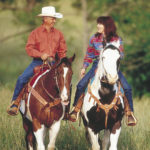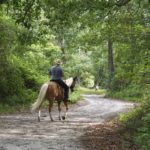When I put my first 30 rides on a horse ? whether it’s a colt I?ve just started under saddle or an older horse that’s new to me ? there are a number of things that I’ll teach or reinforce to the horse.

It?d take a book to talk about everything that need to be accomplished, but I’ll go over a few things that were important to me as I began working with ?Jericho,? a 4-year-old gelding registered as WR Turning Diamonds. I handled him (and later purchased him) at the 2010 Road to the Horse colt-starting challenge. So I had started him under saddle, but when we got home, we had a lot more work to do. Here’s where we started:
Softening to the Bit
Once I’m in the saddle, the most important thing to me is that my horse responds softly to any cue that I give him. If I add pressure to the horse by delivering a cue, as soon as he responds, I release him. That sets up a system. If I consistently release and reward my horse for giving the correct response, that will develop his desire to respond quicker and try harder for me.
I use a snaffle bit for these first rides because it allows me to contact each corner of the horse’s mouth individually. If I touch the right rein, the horse is going to feel pressure in the right side of his mouth. If I touch the left rein, he’s going to feel pressure on the left side of his mouth. And it provides an honest feeling of how he’s responding to me, because it’s a pound-for-pound pressure bit. A curb bit with leverage multiplies a rider?s strength and makes it possible to force a horse to break at the poll, and that’s not what I’m after. I want my horse to respond willingly and softly to a light touch.
The first cue I’m going to give from the saddle will be to pick up a direct rein and add a light pressure to one corner of the horse’s mouth. As I add pressure to that inside rein, I won?t pull my horse’s head around, shortening my rein and forcibly bringing his nose to my knee. I’m going to wait for the horse on the rein, but I will push his body with my legs.
As the horse feels that added pressure on his body, he’s going to seek a release and try to get away from that pressure. I want him to bring his nose off center two to three inches and flex in the poll, dropping his nose slightly toward the point of his shoulder and bringing his face to vertical.
As soon as I feel that response, I release the pressure from both my legs and rein. I only release him on that head position two to three times, then I’m going to add one more step into it and require that before he gets the release, his feet need to follow the direction of his nose.
One of the worst habits developed from softening exercises is horses who are bent consistently from side to side but do not connect it to their feet. These horses are very flexible in their head and neck, but when pressure is added from an outside influence and the emotions raise up, and the rider picks up on that rein, a lot of times that horse will bring his nose over to the rider?s knee but keep right on going in a straight line through his shoulders.
To avoid that habit, or to fix that habit, I am not going to release the rein unless my horse moves his shoulders in the direction of his nose. Or, if I’m asking him to disengage his hindquarters, I will release only when he moves his hindquarters away from the direction of his nose.
This exercise should be practiced at both directions at the walk. When I start getting consistently good results, I take it to a jog, then an extended trot and eventually the lope.
When I start riding this exercise, a lot of times the horse will just go in circles as he tries to figure out what I’m asking for. But as he becomes more and more responsive, the exercise begins to look more like a slalom course, as if I were riding an ?s,? so I call this exercise the ?Circle S.?
As I ride the ?s? shapes, I’ll look where I want to go, take contact with the horse’s mouth, wait for him to bring his nose off center, flex in the poll and then follow his nose with his feet. I immediately release the rein and change directions.
If there is a pause between the release of the rein and the change of directions, the horse is likely to stay sluggish and lean on the bit much longer. If I release the right-hand rein and immediately start the process on the left-hand rein, back and forth, them the horse will start expecting to receive a cue and will be waiting to respond. He?ll get much softer, much lighter, much faster.
Disengaging the Hindquarters and Stopping
My second softening-for-control exercise is teaching the horse to disengage his hindquarters.
I’m going to continue the ?Circle S? exercise but will shorten my inside rein and look over my shoulder at my horse’s hindquarters until his front end stops moving and his hind end steps over? away from his nose. At that point, I release him and ride forward.
You can use the hindquarters to control the horse’s forward movement, and that’s a great way to develop a stop in a horse that doesn’t know how to stop. However, after I?ve been riding a horse more than two or three days, this isn?t the only exercise I’ll use to stop him. I don’t want to dwell on this one-rein stop.
Once I have my horse consistently disengaging his hindquarters and bringing his body to a stop, I start asking him to soften his nose on two reins.
I pick up on the rein, just as I did in the ?Circle S? exercise. I contact his mouth with my right rein and maintain that pressure until the horse recognizes the bit. I maintain the pressure on my right rein and add an equal amount of pressure on my left rein.
This encourages the horse to flex at the poll and bring his face to vertical. When he does that, I release him and tell him what a good job he’s doing.
It’s really important that my horse continues walking or trotting forward through this exercise at a good pace. I want him striding out and going someplace, because as my horse reaches out and moves forward, his hind end will come up underneath his belly and cause him to lift his belly up and elevate his back. That’s the beginning of a collected frame.
If the horse lollygags and drags his feet instead of reaching under himself, he’ll elevate his head, bring his chin in and hollow out his back. That causes both physical and training problems for the horse as he braces against the bit with his lower jaw.
Once my horse is really softening his nose with good forward movement, I ask him to stop straight on two reins.
It’s important to realize that, when pulled on aggressively, the bit is going to stop the first thing it comes to, and that’s the front end. The last thing I want to do is teach my horse to stop on his front end. I want him to stop smoothly off his hind end so I’m not getting jolted out of the saddle and I’m not causing damage to my horse’s front end.
To create a soft stop on the hindquarters using the reins, I ride my horse forward, get his nose really soft in my hands, bring his face to vertical and keep a soft contact on the reins. Once I have the horse soft in my hands, I’m going to softly say ?Whoa.?
I’ll give the horse two seconds to respond (counting ?one thousand one, one thousand two?). If he has not responded, I pick up on one rein. Then maintaining pressure on the first rein, I lift the second rein and apply pressure. This keeps my horse’s neck straight forward, but it puts a twist in your bit, which causes the horse enough discomfort that he will immediately stop. I’ll back him up to a point where I first said ?Whoa,? drop the reins and let him sit and think for a minute.
I’ll practice this exercise at a walk until the horse becomes proficient, then move into a trot, an extended trot and eventually a lope. In no time at all, my horse will be stopping off the ?Whoa.?





